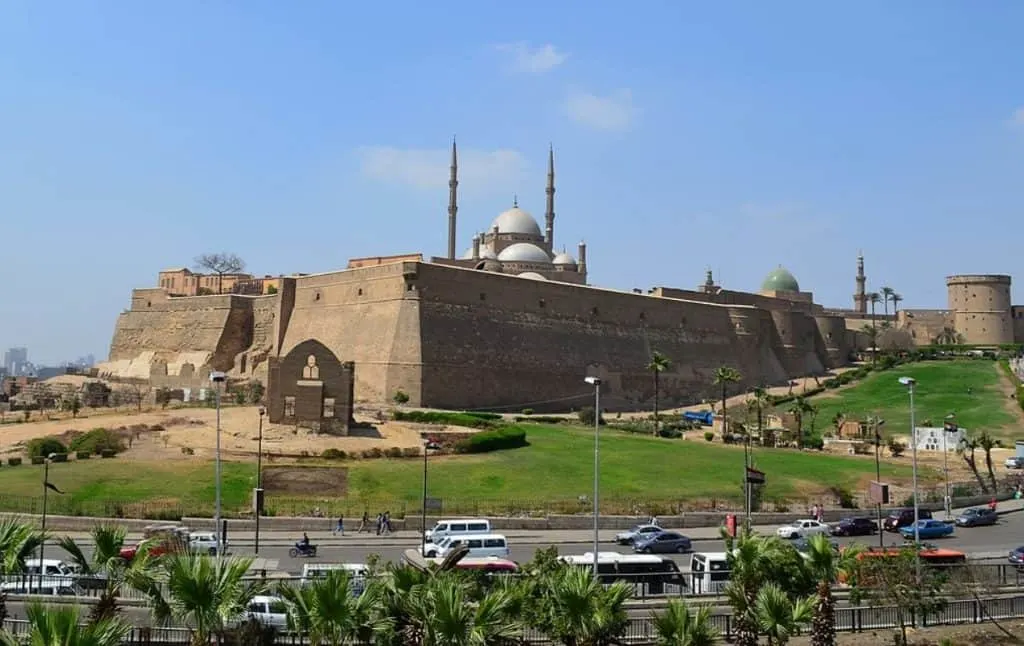There are very few countries in the world that have such a rich history dating back thousands of years ago. The first kingdom in the country was established in 3150 B.C., followed by the construction of immense buildings.
Today, the ruins of famous temples and pyramids can be found along the Nile River, including some of the most fascinating buildings ever constructed.
Combine this with the remarkable Roman and Muslim architecture and you’ll find a well-diversified number of architectural highlights.
In this post, you’ll discover the 25 most famous buildings in Egypt, structures located in a country that you simply have to visit once in your life.
1. Great Pyramid of Giza
The Great Pyramid of Giza is the biggest of all Ancient Egyptian pyramids and is located in the Giza necropolis just outside of Cairo.
It is also the oldest of the 3 big pyramids that were constructed in the complex and it was built during the 4th Dynasty between 2580 and 2560 B.C.
Based on writings inside the pyramid we know that it was built by Pharaoh Khufu. With a height of 146.7 meters (481 feet), it was the tallest building in the world for a period of 3,800 years
It’s easily one of the most famous landmarks in the entire world, ranked as one of the 7 wonders of the ancient world, and included in the New 7 wonders list as well.
Official website: The Great Pyramid

2. Temple of Hatshepsut

The Temple of Hatshepsut is also known as “Djeser-Djeseru” and is the mortuary temple of the female Pharaoh Hatshepsut.
She ruled during the 18th dynasty and died in the year 1458 B.C. The temple is located beneath massive cliffs at Deir el-Bahari which gives it an amazing look.
One of the most remarkable facts about Hatshepsut is that very little info remains of the woman because her stepson, Thutmose III, tried to erase her from history after her death.
Some reliefs that survived clearly depict the birth of a female pharaoh though which tells just part of the tale of Hatshepsut.
Official website: Hatshepsut Temple
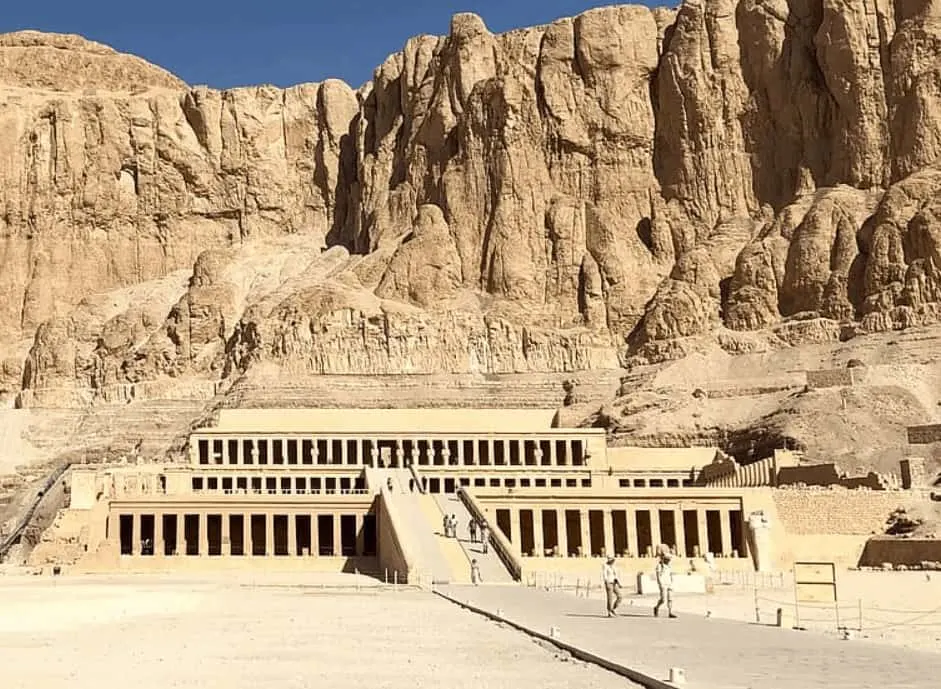
3. Pyramid of Djoser
The Pyramid of Djoser is a step-pyramid located in the Saqqara Necropolis, which served as the main necropolis for the Ancient Egyptian city of Memphis.
It was built between 2670 and 2650 B.C. and is considered to be one of the earliest large-scale construction projects in human history, and was the predecessor of all pyramids that followed.
With a height of 62.5 meters (205 feet), it was by far the tallest building in the world upon completion, a title it held until it was surpassed by the Great Pyramid of Giza.
It’s believed the pyramid was based upon the Saqqara Mastaba which dates back to around 2700 B.C.
Official website: Djoser Pyramid
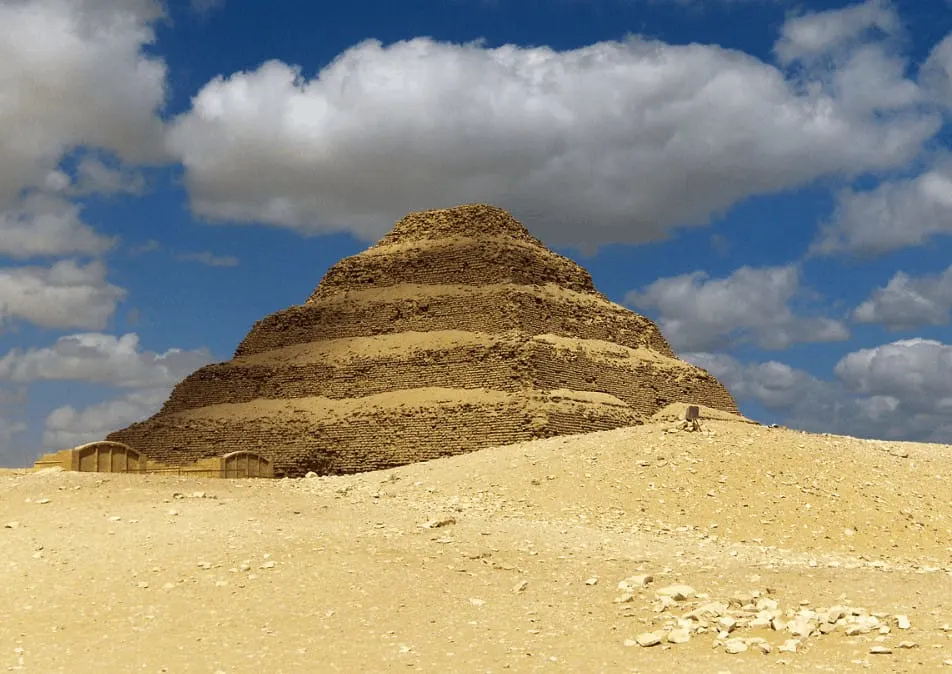
4. Karnak Temple Complex
The Karnak Temple Complex is mostly referred to as just “Karnak” and consists of numerous buildings such as temples, chapels, pylons, and numerous sculptures.
The complex is located near the city of Luxor and the area was considered to be one of the “Most Selected of Places” in Ancient Egypt.
For this reason, the complex construction started in the “Middle Kingdom,” between 1700 and 2000 B.C. and continued all the way to the Ptolemaic period, between 305 and 30 B.C.
Most of the remaining structures were built during the “New Kingdom” and this temple complex is one of the most fascinating places to visit in Egypt.
Official website: Karnak Temple on WMF
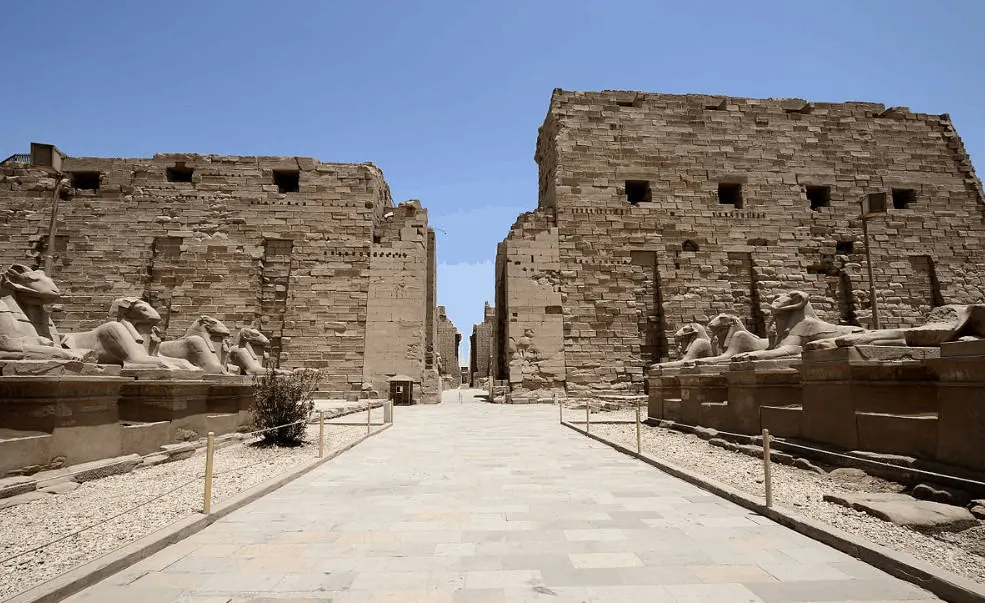
5. Luxor Temple
The Luxor Temple Complex is located right within the city of Luxor, which used to be referred to as “Thebes” in Ancient Egypt.
It was constructed around 1400 B.C. The temple is unique in the sense that it wasn’t dedicated to a god or to a deified Pharaoh.
Instead, it was dedicated to the “rejuvenation of kingship” and it’s most probably the place where a lot of the pharaohs in Ancient Egypt were crowned.
During Roman times, the temple was used as a fortress and home of the government. A Roman Legion was stationed in the temple as well.
Official website: Luxor Temple on WMF
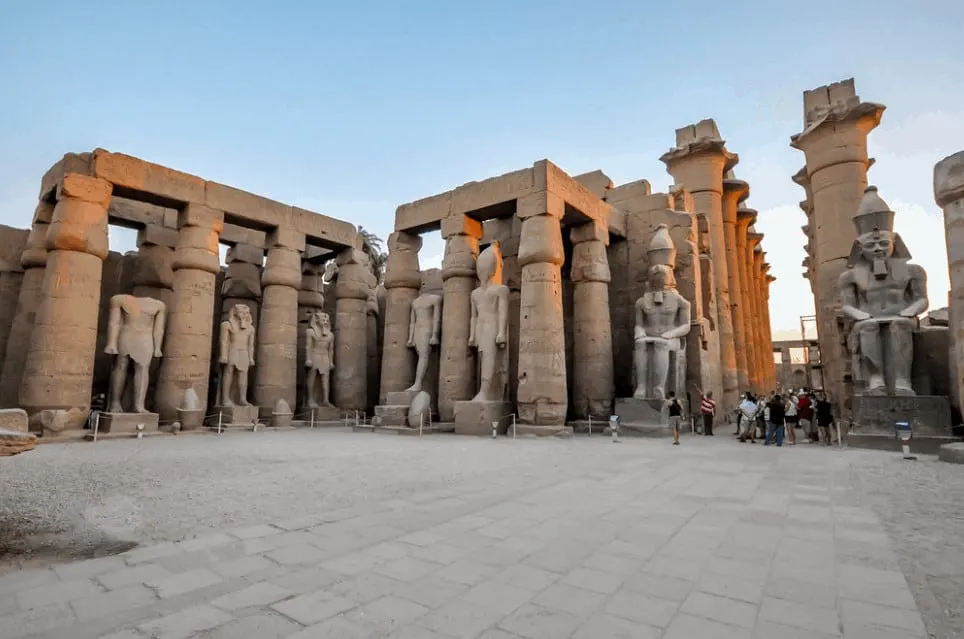
6. Abu Simbel
The Abu Simbel Temples are a temple complex consisting of two massive temples that were carved out of the rocks near the village of Abu Simbel in southern Egypt.
They were constructed during the 19th dynasty around the year 1300 B.C. and commemorate the victory of Pharaoh Ramesses II and his queen Nefertari during the Battle of Kadesh.
One of the most remarkable facts about the temples of Abu Simbel is that they were relocated in their entirety to make way for the construction of the Aswan High Dam on the River Nile.
If not, these famous buildings in Egypt would have been submerged during the creation of Lake Nasser, the reservoir of the dam.
Official website: Abu Simbel

7. Pyramid of Khafre
The Pyramid of Khafre is the second-tallest pyramid in the Giza Necropolis just outside of Cairo.
It was built as a tomb for the Pharaoh Khafre, also referred to as “Chephren,” who ruled during the 4th Dynasty between 2558 and 2532 B.C.
This pyramid isn’t that much shorter than the Great Pyramid of Giza as it originally stood 143.5 meters or 471 feet tall.
Its base is quite a bit smaller though which makes this pyramid much steeper than its taller neighbor.

8. Valley of the Kings
The Valley of the Kings is also sometimes referred to as the “Valley of the Gates of the Kings” and is a valley in Egypt consisting of numerous great tombs of pharaohs and other important people in Ancient Egypt.
These tombs were cut out of the rocks during the New Kingdom for a period of 500 years between 1600 and 1100 B.C.
The valley is located on the west bank of the Nile right across the city of Luxor, or Thebes in Ancient Egypt.
It’s located right in the middle of the Theban Necropolis. The valley contains a total of 63 tombs of which some contain numerous chambers (one tomb contains 120 chambers)!
Official website: Valley of the Kings

9. Valley of the Queens
As you might have expected, the Valley of the Queens was the burial site of the wives of the pharaohs who were buried in the tombs located at the Valley of the Kings.
In ancient Egypt, this valley was known as “Ta-Set-Neferu,” which literally translates to “the place of beauty.”
The main area, referred to as a “Wadi,” contains a total of 91 tombs, while the additional areas add an additional 19 tombs.
The Valley of the Queens is located near the Valley of the Kings and was used between the 17th and 20th dynasties.
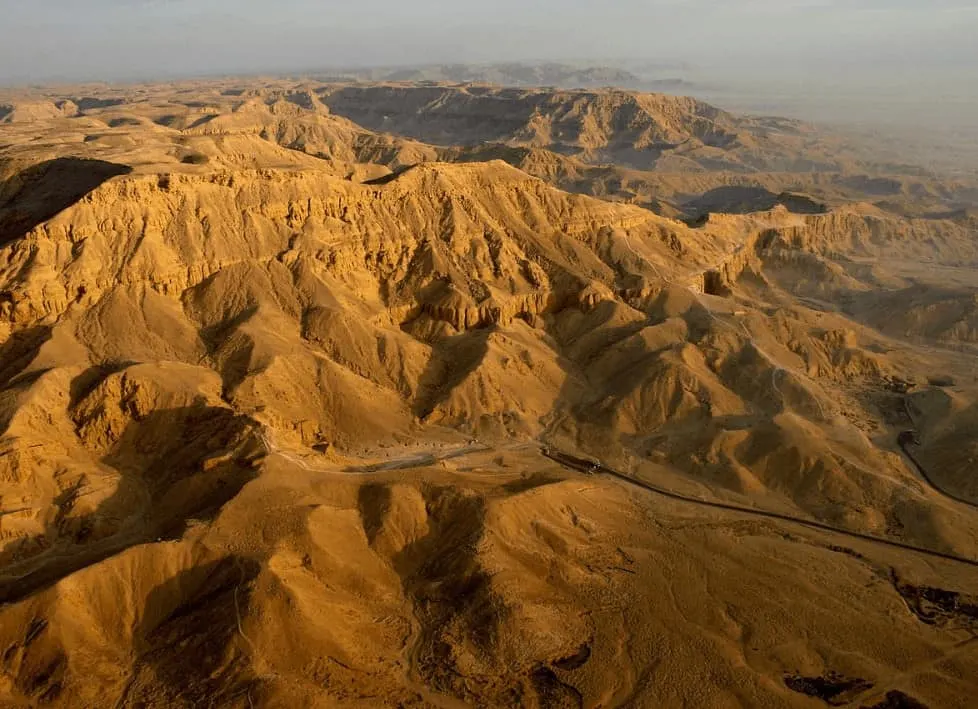
10. Great Sphinx of Giza
The Great Sphinx of Giza, also referred to as just the Sphinx of Giza is probably the most iconic monument that the Ancient Egyptians left behind.
It’s a limestone sculpture located within the Giza Necropolis and depicts a sphinx, a mythical creature with the body of a lion and the head of a human.
The sculpture is located in the vicinity of the Pyramid of Khafre and it’s assumed that the face of the sphinx is actually that of Pharaoh Khafre.
The sculpture doesn’t look that big but it’s actually 73 meters (240 feet) long in its entirety and stands about 20 meters (66 feet) tall.
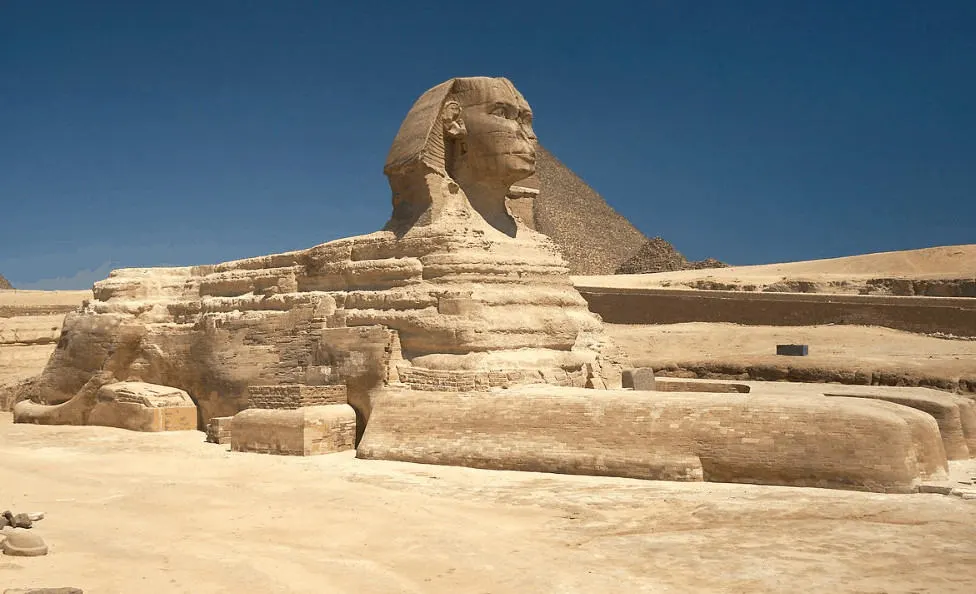
11. Red Pyramid
The Red Pyramid, located in the Dahshur Necropolis near Cairo, was one of the most important structures that were built in Ancient Egypt.
It was the first-ever smooth-sided pyramid that was actually successfully constructed and formed the inspiration model for all the pyramids that followed, most importantly, the Great Pyramid of Giza.
The pyramid was built by Pharaoh Sneferu, also known as “Soris,” and construction started around 2590 B.C., making it one of the oldest large-scale pyramids in Egypt.
It’s named after the red glow of the limestone used to build it, even though in ancient times it was completely covered in white limestone.
Sneferu was the father of Khufu who built the Great Pyramid and is considered to be the greatest builder in all of Ancient Egypt, and that means something.
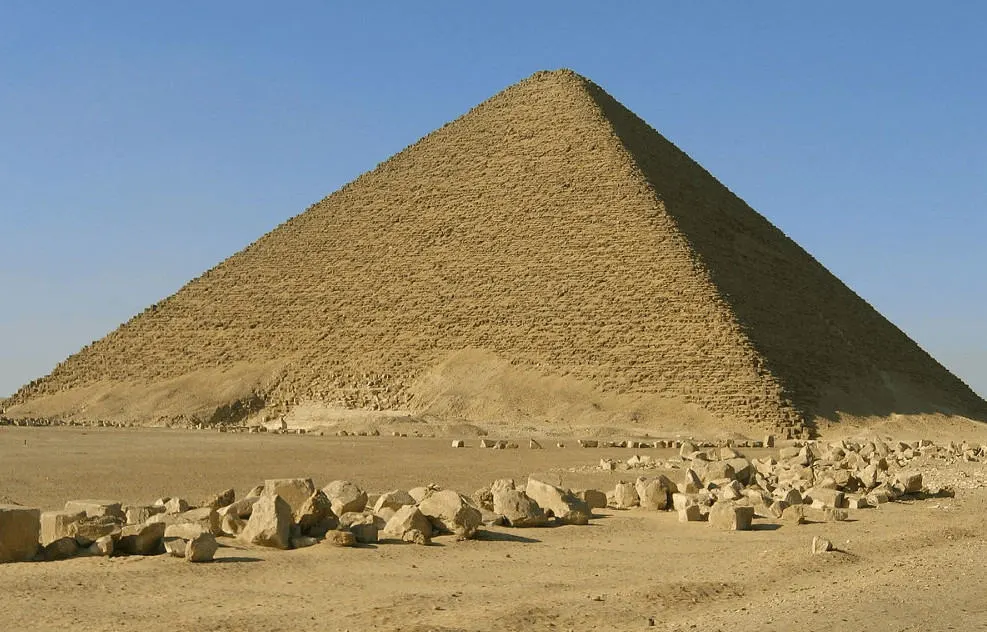
12. Cairo Tower
The Cairo Tower is one of the most famous modern buildings in Egypt and is located on Gezira Island in the River Nile in the Gezira district, just near Downtown Cairo.
It’s one of the most prominent landmarks in the city as it stands 187 meters (613.5 feet) tall, which doesn’t just make it the tallest structure in Egypt but all of North Africa as well.
The famous tower was constructed between 1955 and 1961 and was indirectly funded by the United States government when Kermit Roosevelt and the CIA attempted to bribe then Egyptian president Nasser.
This backfired and Nasser instantly used the funds to start building the tower.
The tower has an observation deck and multiple restaurants, including a revolving one, and is one of the most popular tourist attractions in the city.

13. Bent Pyramid
The Bent Pyramid was the first pyramid to be constructed at the Dahshur Necropolis south of Cairo.
It was built by the founder of the 4th Dynasty in the Old Kingdom named Sneferu, who also built the Red Pyramid.
It was his first attempt to build a smooth-sided pyramid as opposed to the step-pyramids which were constructed before.
Unfortunately for Sneferu, something went horribly wrong as they clearly miscalculated the angle from which the pyramid should rise.
Because of this, the angle was changed before halfway, resulting in a peculiar bent. This is also how the pyramid got its modern name.
It’s one of the most famous landmarks in Egypt because it’s one of the oldest, yet best-preserved pyramids in the country. A lot of the limestone casing is still present as well.
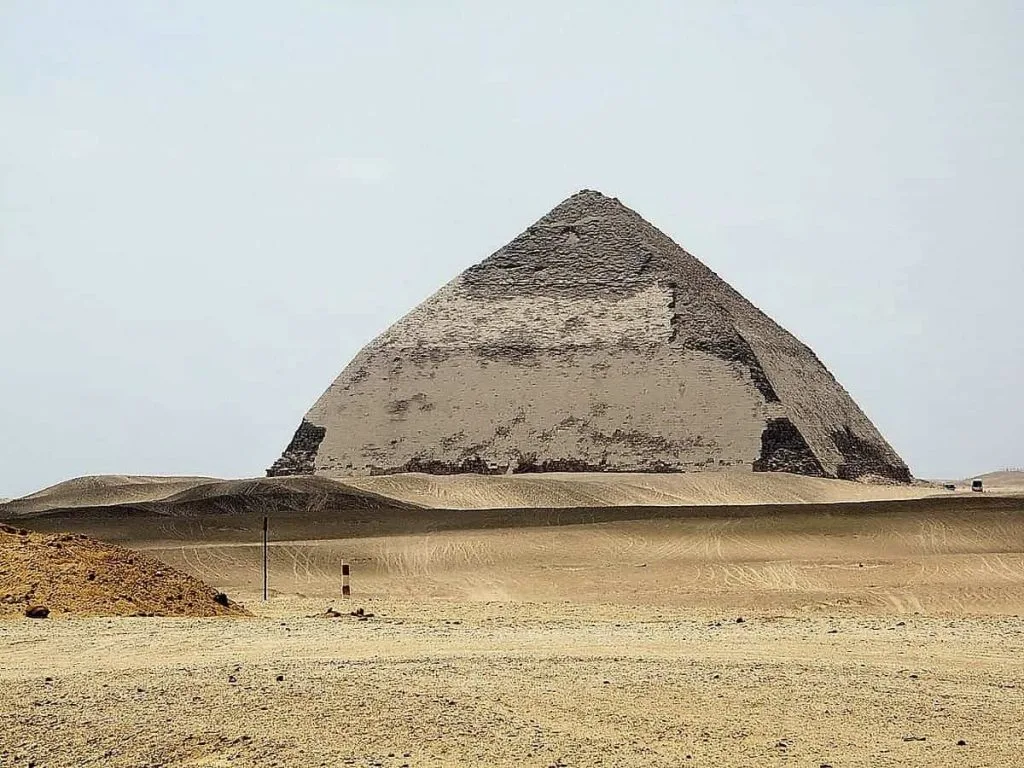
14. Colossi of Memnon
The Colossi of Memnon are two massive statues located in the Theban Necropolis, the large mortuary complex on the West Bank of the Nile River across the modern-day city of Luxor.
They were originally the guards of the enormous Temple of Amenhotep, built during the reign of Amenhotep III in the 18th dynasty about 1350 B.C.
This is believed to have been the largest temple ever constructed in Ancient Egypt, covering an area of about 35 hectares (86 acres).
Both statues are utterly unrecognizable today but are believed to have been depicting Amenhotep the Magnificent himself.
Various earthquakes completely flattened the temple and destroyed parts of the statues as well. The northern statue has been reconstructed at the end of the 2nd century A.D. by the Romans.

15. Temple of Horus at Edfu
The Temple of Horus is located in the town of Edfu in the southern part of Egypt. It’s situated in between the major cities of Luxor and Aswan, an area which features countless fascinating landmarks.
This temple was dedicated to one of the most important deities of Ancient Egypt called Horus, a god who was worshipped for thousands of years.
This massive structure was built during the Ptolemaic Dynasty, the final dynasty of Ancient Egypt which ended with the death of Cleopatra in the year 30 B.C.
It was constructed between 237 and 57 B.C. and was one of many huge construction projects that were completed during the reign of the Ptolemaic rulers.
It was the setting of one of the biggest festivals of Ancient Egypt which celebrated the marriage between Horus and his goddess Hathor, resulting in a yearly pilgrimage to the temple as well.
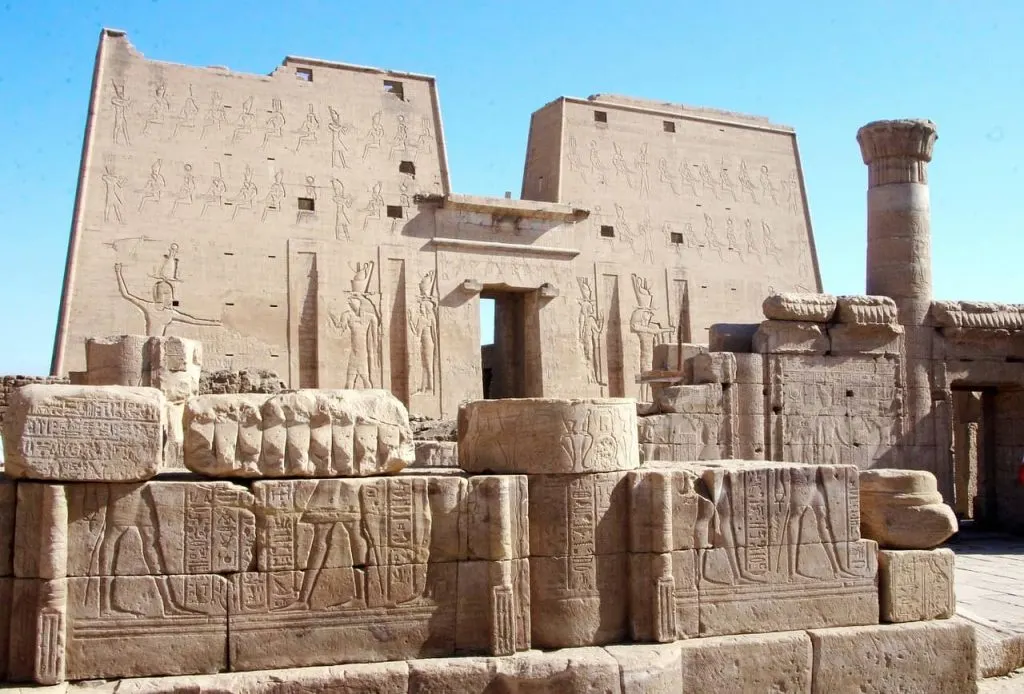
16. Pyramid of Menkaure
The Pyramid of Menkaure is the smallest of the 3 main pyramids at the Giza Necropolis just outside of Cairo.
It was built during the 4th Dynasty by Pharaoh Menkaure to serve as his tomb, just as how his father Khafre and his grandfather Khufu did before him.
The pyramid is also adjoined by 3 satellite pyramids which were most probably built for the wives of Menkaure.
Certainly, Menkaure never saw his own pyramid completed because an inscription was found on the walls of his mortuary temple nearby that his son completed his work.
The pyramid was also left half-finished as the upper part was clad with Tura limestone while the lower section used red granite imported from Aswan.
In the late 12th century, the Sultan of Egypt attempted to destroy the pyramid but he gave up upon realizing the impossible task at hand, only leaving permanent damage to it in the process.

17. Medinet Habu
Medinet Habu is an archaeological site on the west bank of the River Nile near Luxor.
It’s famous for featuring the mortuary Temple of Ramesses III, the second pharaoh of the 20th Dynasty of ancient Egypt who is assumed to have reigned between 1186 to 1155 B.C. and one of the last great monarchs of the New Kingdom.
The temple is an enormous structure with a length of about 150 meters (490 feet) featuring multiple courtyards and rows of columns as is common in similar temples.
The entire temple complex covering an area of 7,000 square meters (75,347 square feet).
The temple is famous for depicting the victory against the so-called “Sea Peoples” during the reign of Ramesses III.
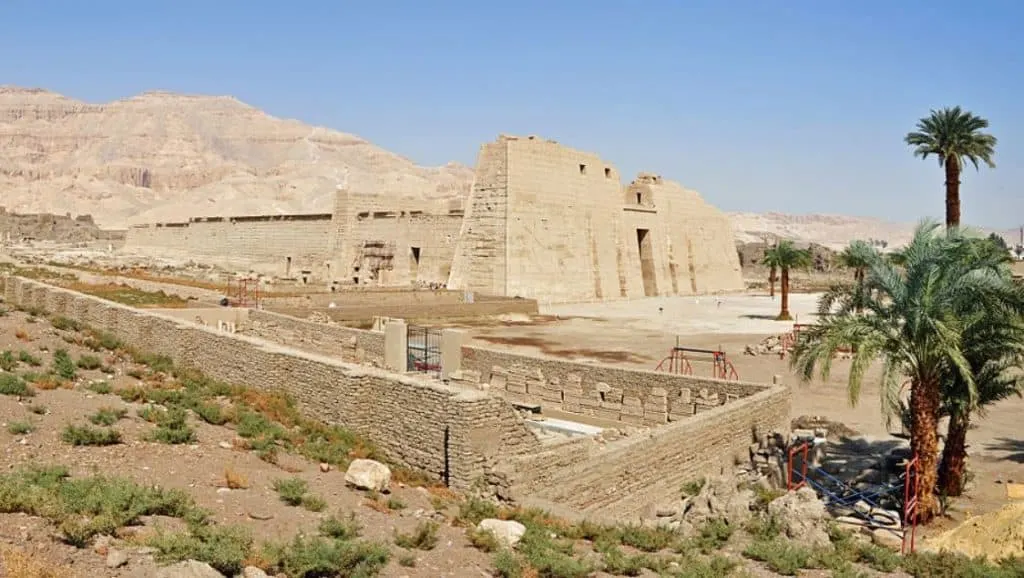
18. Philae
Philae is an island situated within the reservoir of the Aswan Low Dam near Aswan in southern Egypt.
The island, which featured a massive temple complex, was originally located in a totally different location but this area was flooded during the construction of the Aswan High Dam in the 1970s.
Similar to how the temple of Abu Simbel was moved to a different location before the construction of the Aswan High Dam, the temple complex of Philae was moved to the Agilkia Island in order to preserve it.
The original term “Philae” was mentioned by ancient writers as plural so it’s most likely that the temple complex was located on two separate islands.
Today, the complex is one of the most popular tourist attractions near Aswan and one of the most famous buildings in Egypt!
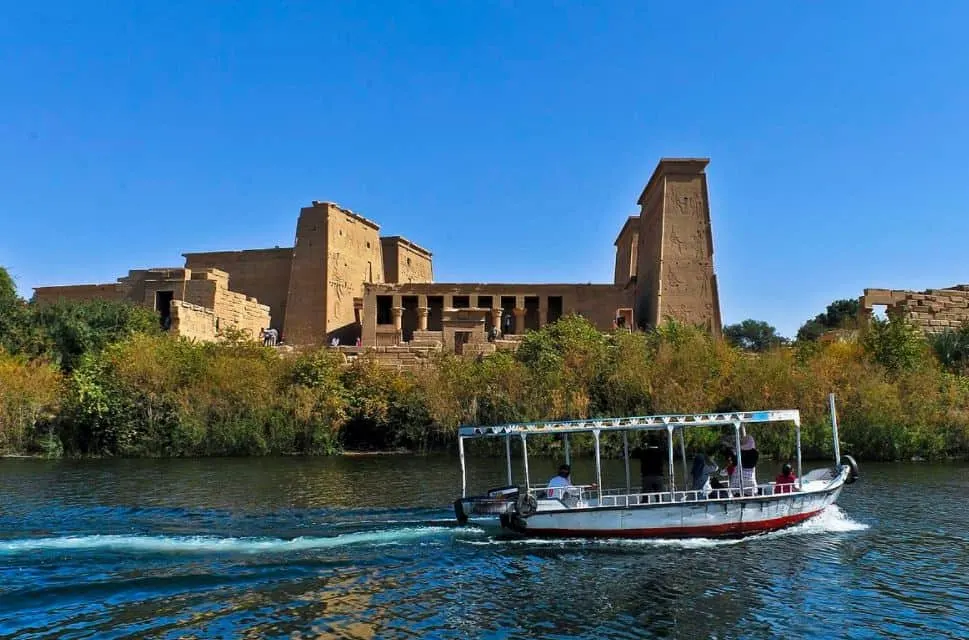
19. Al-Azhar Mosque
The Al-Azhar Mosque is known in Egypt as simply “Al-Azhar” and is one of the most fascinating Islamic structures in the country.
It was originally established as the centerpiece of the newly established capital of the Fatimid Caliphate in the year 980 A.D. It was the first mosque that was ever built in Cairo as well.
The mosque is adjoined by Al-Azhar University, one of the most prestigious Islamic universities in the world and the second-oldest continuously run university in the world as well.
Even though the Mosque and University are considered to be some of the most influential institutions in Egypt today, this wasn’t always the case over the course of the centuries.
Official website: Al Azhar Mosque

20. Temple of Kom Ombo
The Temple of Kom Ombo is another ancient Egyptian Temple in the Aswan region in southern Egypt.
It’s a more recent temple because it was built during the Ptolemaic dynasty (305-30 B.C.) between the years 180 and 47 B.C. Some additions even date back to Roman times.
The most unique part of this temple is that it was designed as a double temple in order to worship two different gods.
These gods were the crocodile god Sobek that was worshipped in the southern part of the temple, while the falcon god Horus was worshipped in the northern part.
The temple has been completely restored as it was seriously damaged by earthquakes and the Nile.
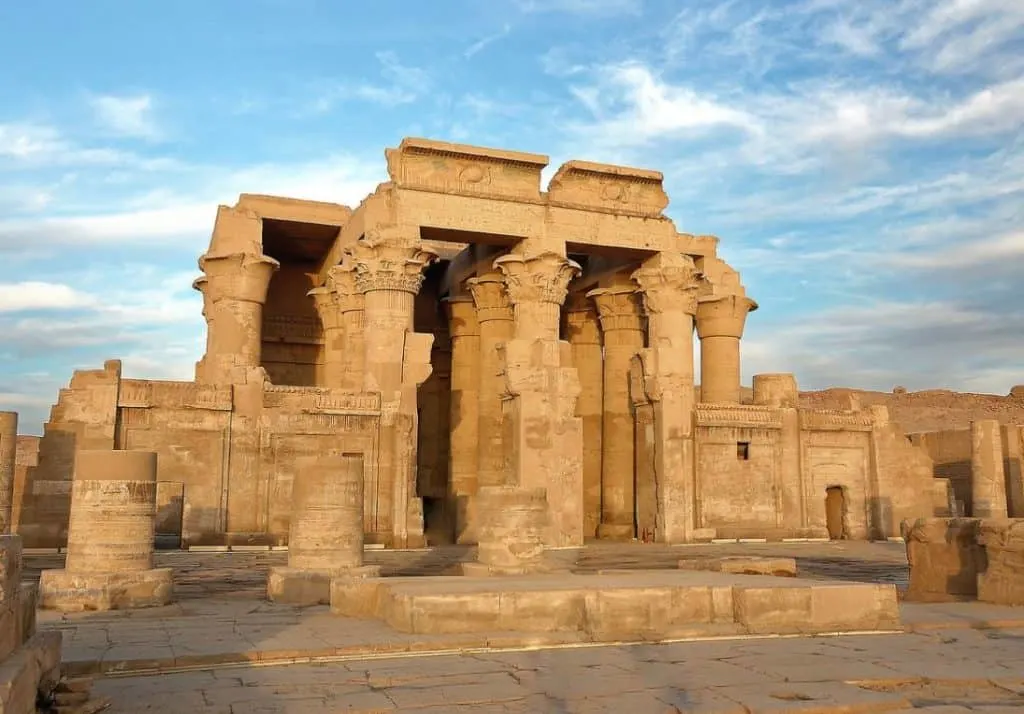
21. The Manial Palace
The Manial Palace is one of the most stunning palaces in Egypt. It’s located on Rhoda Island in the southern part of Cairo in the city’s “El-Manial” district.
The palace was built during the “Alawiyya dynasty,” also known as the “Muhammad Ali dynasty” in reference to the man who is considered to be the founder of modern Egypt.
The palace was built by Prince Mohammed Ali Tewfik (1875-1955) who was the uncle of King Farouk.
It was built using a wide variety of architectural styles, including the Ottoman, Moorish, Persian, which were combined with European styles such as Art Nouveau and Rococo architecture.
There’s also a Persian Garden which is integrated into an immense English landscaped garden surrounding the palace grounds.
Official website: Manial Palace and Museum
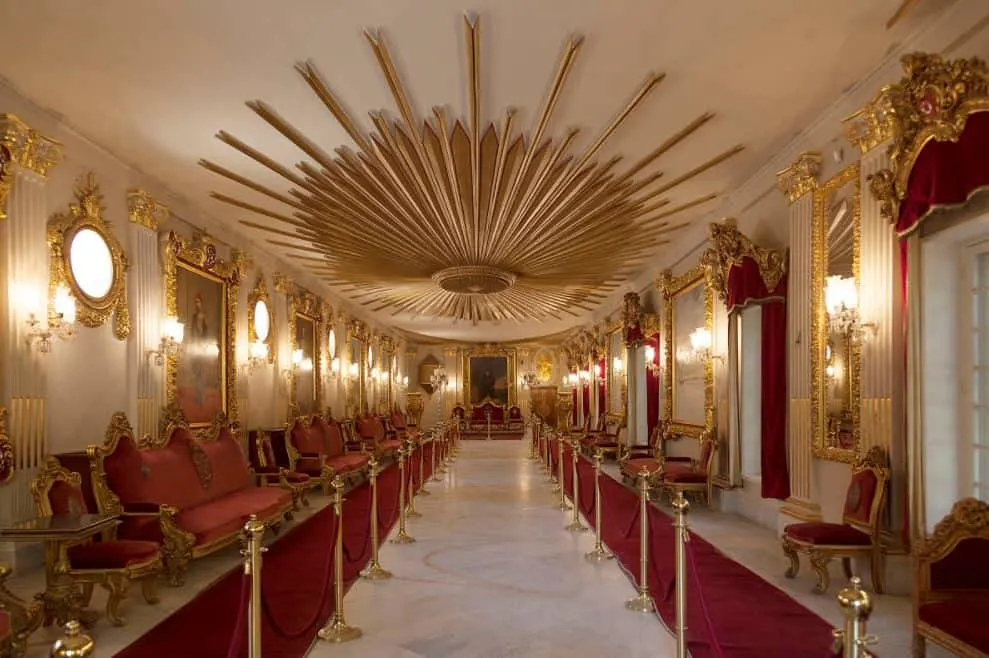
22. Pyramid of Meidum
The Pyramid of Meidum is located at Meidum in Lower Egypt just south of Cairo.
It’s considered to be the second-oldest pyramid ever constructed after Djoser’s step pyramid and was presumably started by Huni, the last Pharaoh of the 3rd Dynasty (2686 – 2613 B.C.), the first dynasty of the Old Kingdom.
The pyramid was presumably completed by Snefuru, the builder of the Bent Pyramid.
Similar to how the engineers made crucial mistakes with the Bent Pyramid, this one featured a lot of structural errors.
It’s believed to have been a step pyramid but the top section was turned into a true pyramid using limestone.
Because the outer layer was constructed on sand, it partially collapsed in ancient times, resulting in this peculiar-looking structure.
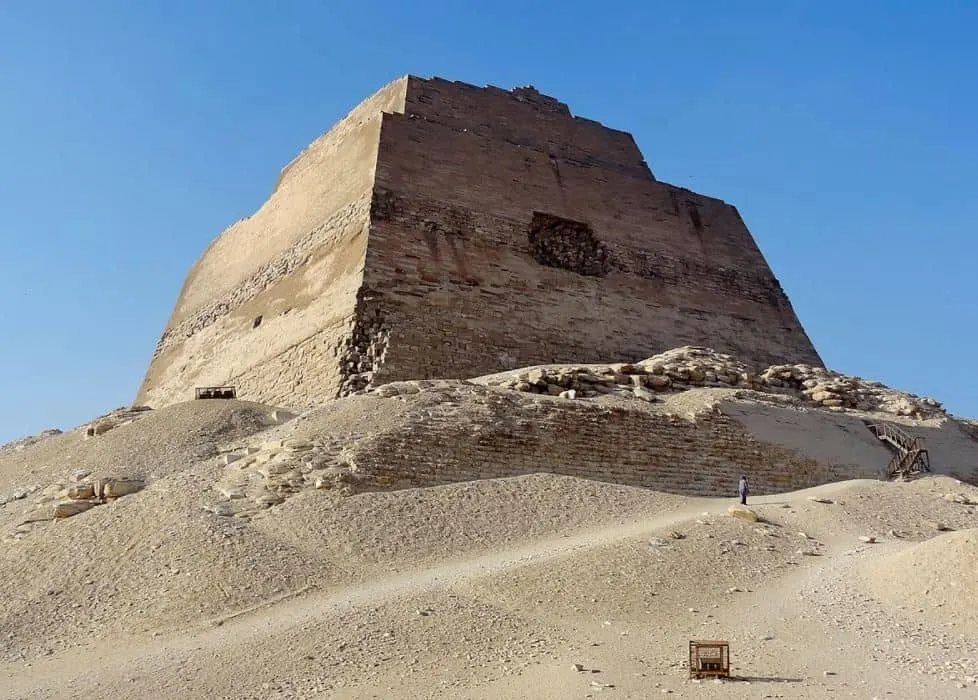
23. Pompey’s Pillar
Pompey’s Pillar is one of the most remarkable ancient Roman monuments in Egypt.
It’s a huge triumphal column located on the eastern side of the Serapeum of Alexandria, an ancient Greek temple in the city.
This enormous temple was built by Ptolemy III Euergetes between 246 and 222 B.C., which was during the Ptolemaic Kingdom.
Even though the column was erected by Emperor Diocletian between 298 and 303 A.D., it is today known as “Pompey’s Pillar” because of a misreading on the column’s pedestal.
This enormous structure featured a large statue of the emperor on top of it in ancient times but is now lost. This element further elevated the 26.85-meters (88 feet) pillar by 7 meters (23 feet).
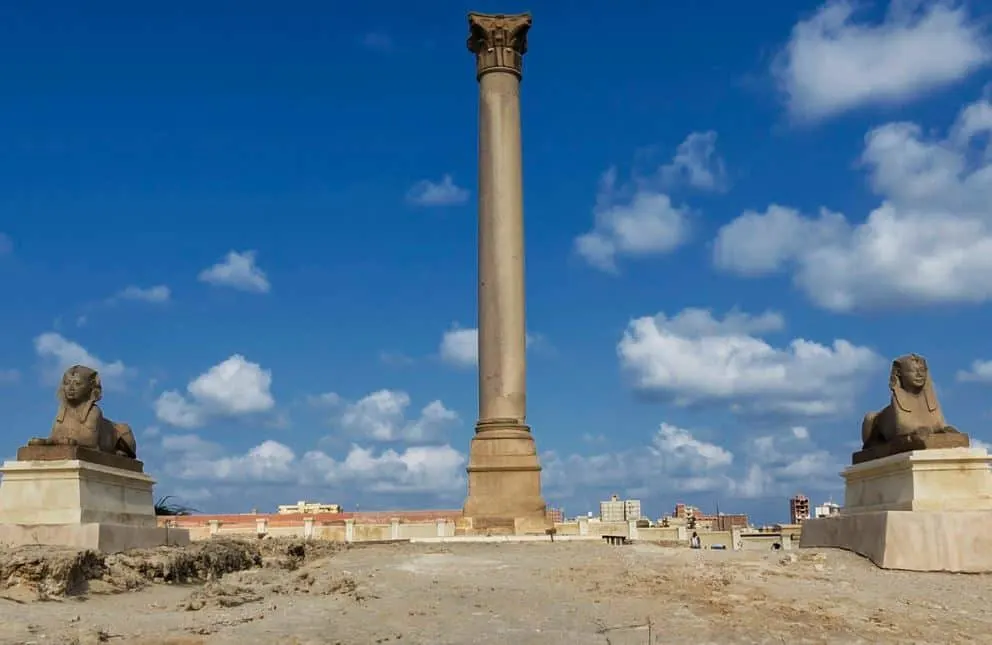
24. Catacombs of Kom El Shoqafa
The Catacombs of Kom El Shoqafa is another historical landmark in the city of Alexandria.
It’s an immense necropolis that dates back to ancient Egyptian times and was modified during the Hellenistic and Imperial Roman periods as well. Therefore, the catacombs and their tombs feature a wide variety of styles.
One of the most fascinating features of the catacombs is the “Hall of Caracalla,” an area specifically designed to house the remains of the horses of Emperor Caracalla in the year 215 A.D.
It’s possible for visitors to enter the first of the 3 levels of the catacomb through a hole that was made into the bedrock at an unknown date.
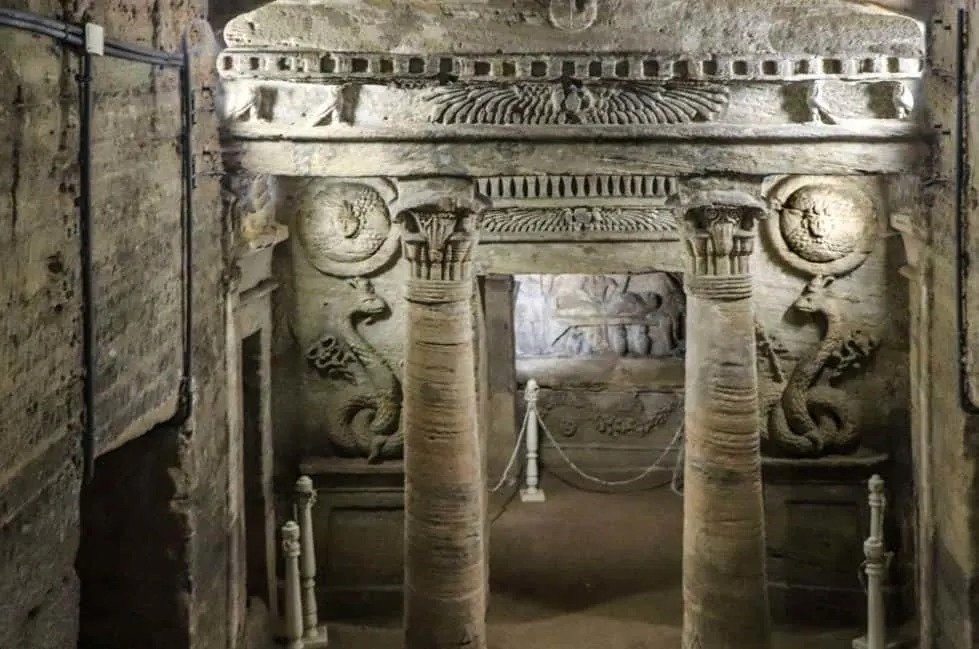
25. Cairo Citadel
The Cairo Citadel is also known as the “Citadel of Saladin” in reference to the man who ordered its construction, Salah ad-Din or Saladin (1137-1193), the first Sultan of Egypt.
It was one of the most important buildings in Cairo for over 700 years as it was used as the seat of government and the residence of Egypt’s rulers between the 13th and 19th centuries.
This means that the original fortification built by Saladin was seriously expanded over the centuries by a number of subsequent rulers.
The Citadel is located in a hilly area referred to as the Mokattam hills in the southeastern part of the city.
This means that it overlooks the city which was an extremely strategic position for military purposes. It’s now one of the most famous buildings in Egypt featuring several mosques and museums.
Official website: Cairo Citadel
